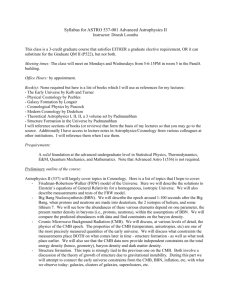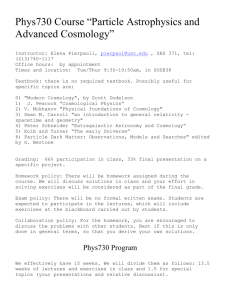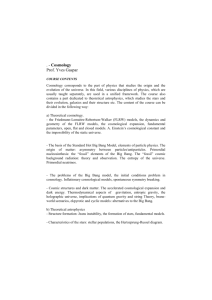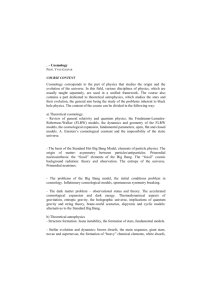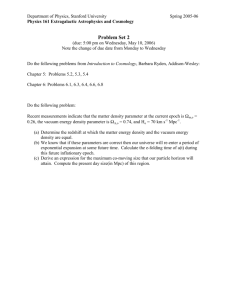The Dark Matter Puzzle: On the Home Stretch 10 August 2007
advertisement
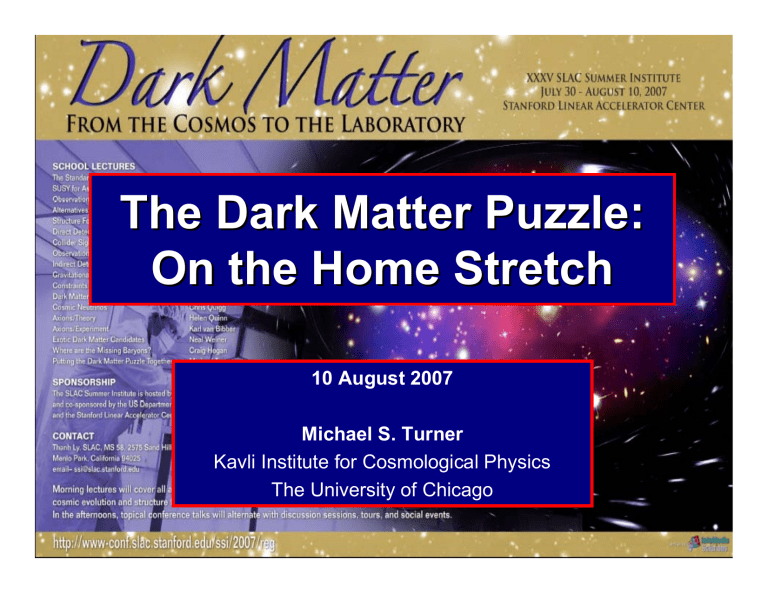
The Dark Matter Puzzle: On the Home Stretch 10 August 2007 Michael S. Turner Kavli Institute for Cosmological Physics The University of Chicago Quarks & Cosmos Dark Matter is the Central Front of Quarks & Cosmos A Brief History of Cosmology Boom or Bust (Punctuated equilibrium powered by ideas and technology) 1916-1918: General Relativity & Λ PS: Never mind on Λ Just One Number K (H0) (error bars not needed, velocity in km) K = 550 km/s/Mpc Hubble & Humanson: few 100 galaxies, z < 0.1 Landau on Cosmologists Often in Error, Never in Doubt! Cosmology: The Search for Two Numbers … Sandage 1970 “The Standard Model” Hot Big Bang (circa 1972) “Reality (physics) Based” • BBN (nuclear physics) • CMB (atomic physics) • Structure Formation (grav. physics) • Begins at 0.01 sec • Ω0 ~ 0.1 (baryons) Big Questions • “The naughts” • Large entropy per baryon • Flatness, Oldness • Origin of density perturbations • Λ problem 1980s: The Go Go Junk Bond Days of Early Universe Cosmology “Creativity Based” • Inflation • Cosmic Strings • Baryogenesis • Magnetic Monopoles • Phase Transitions • Hot and Cold Dark Matter • Decaying Particles • Kaluza-Klein 1990s: Beginning of Data-driven Cosmology • • • • • COBE! and CMB experiments Redshift surveys (CfA, IRAS, 2dF, SDSS) Large-scale velocity field measurements Gravitational lensing Big telescopes (Keck, …) with big CCD cameras • X-ray, gamma-ray, IR, … 2000s: Era of Precision Cosmology • • • • • “Fisher Based” Cosmological parameters Tests of inflation, CDM Correlating large, complex data sets Cosmological Consistency Physical parameters (e.g., neutrino mass) “The New Cosmology” (Concordance Cosmology) •Standard Hot Big Bang of the 1970s •Flat, accelerating Universe •Composed of: atoms, exotic dark matter, and dark energy •Inflation knocking at the door (first strong evidence: CMB, LSS) •Precision set of cosmological parameters Consistent with –Ω0 = 1.00 ± 0.01 –ΩM = 0.24 ± 0.02 –ΩB = 0.042 ± 0.002 –ΩΛ = 0.76 ± 0.02 –H0 = 73 ± 2 km/s/Mpc –t0 = 13.7 ± 0.2 Gyr all data, laboratory and cosmological! “The New Cosmology” (Concordance Cosmology) •Standard Hot Big Bang of the 1970s •Flat, accelerating Universe •Composed of: atoms, exotic dark matter, and dark energy •Inflation knocking at the door (first strong evidence: CMB, LSS) •Precision set of cosmological parameters –Ω0 = 1.00 ± 0.01 –ΩM = 0.24 ± 0.02 –ΩB = 0.042 ± 0.002 –ΩΛ = 0.76 ± 0.02 –H0 = 73 ± 2 km/s/Mpc –t0 = 13.7 ± 0.2 Gyr Precision Cosmology Science A Brief History of Dark Matter The First Missing Matter Puzzle: Helium 1868: Janssens and Lockyer 1895: Ramsay solves puzzle by find evidence for new element, the D3 line isolating He gas produced by cleveite Which City Will Be Know As The City Of Dark Matter? National Helium Monument Celebrating 100th Anniversary of Discovery 1935: Zwicky, Coma and Dark Matter The Gravity of the Stars is not Enough to Hold Clusters Together Clusters Must be Held Together by the Gravity of Unseen “Dark Matter” Cosmology was very young, clusters were new, and astronomy was not ready for dark matter (or most of Zwicky’s ideas) Astrophysical Hints for Galactic Dark Matter Halo Deuterium Used as Baryometer to constrain baryon density Best Fit Universe •H0 ~ 60 km/s/Mpc •Ω0 ~ ΩB ~ 0.1 •t0 ~ 14 to 18 Gyr 1970s: Vera Rubin and Flat Rotation Curves Dark Matter Close to Home 1000s of Rotation Curves 1980: X-Rays Reveal that Some of the Cluster “Dark” Matter is Hot Gas 1980: Particle Dark Matter!? Ων = mν/91h2eV Neutrinos and Cosmology 1981-1982: Inflation - Flat Universe and origin of density perturbations Almost Scale-invariant Perturbations: Hot and Cold Dark Matter Theories 1984: Inner Space/Outer Space the Woodstock of Quarks & the Cosmos The Rise of CDM as the Theory to Knock Off 1985: Official Birth of WIMPs 1992: COBE Changed it all by providing, accurate large-scale normalization: Flavors of CDM Science 274, 69 (1996) CDM: The Theory with 9 Lives Mapping Dark Matter 2001: Nailing Down the Baryon Density CMB (first to second peak) Ωbh2 = 0.022 ± 0.0007 vs. BBN (Deuterium) Ωbh2 = 0.021 ± 0.001 5% agreement Ωb = 0.042 ± 0.002 The Rise and Fall of Omega ΩM 1 0.3 0.1 1970 • • • • 1970s: 1980s: 1990s: 2000s: 1980 1990 2000 Mass-to-light ratios on limited parts of the galaxy Peculiar velocity measurements probe larger regions Cluster fair sample, LSS, peculiar flows CMB, LSS, BAO, clusters … and the winner is ΛCDM 1979 vs. 2007 Cosmic Web of Dark Matter Dark Matter: Where We Are Today 10 Things to Take Home 1. Overwhelming Evidence for Dark Matter • Flat rotation curves of galaxies (galaxies have large, dark halos) • Clusters are held together by dark matter (galaxy motions, lensing maps, x-ray gas) • CMB census of stuff in the Universe • Without gravity of dark matter cannot make observed structure • CDM has most of the truth 2. Dark Numbers • • • • • Stars: ~0.5% (definition dependent) Atoms: 4.2 ± 0.2% Dark Atoms: ~3.7% (90% of atoms) Exotic Dark Matter: 20 ± 2% Neutrinos: 0.02% to 1% …. the rest is dark energy 3. Concordance Model Doesn’t Exist w/o Particle Dark Matter! 4. Airtight Evidence for Nonbaryonic Dark Matter CMB & BBN Ωbh2 = 0.021 ± 0.001 vs. CMB/SDSS ΩMh2 = 0.13 ± 0.005 20σ discrepancy 5. Clusters: Nature’s Fair Sample of the Cosmos • • • • Stars: ~2% Hot gas ~14% Exotic Dark Matter ~84% Consistent with universal mass ratios 5. Strongest Evidence for Physics Beyond the Standard Model and #8 in Haber’s Top Ten List for Believing in SUSY 6. Dark Matter Candidates The Neutralino is very attractive, but don’t forget the axion 7. Full Court Press on Dark Matter 7. Full Court Press on Dark Matter • Particle accelerators (Tevatron, LHC, ILC) • Direct searches for halo dark matter – Axions and neutralinos (multiple techniques) – Within reach of detection! • Indirect searches – Sun/earth annihilation neutrinos – Halo annihilation positrons, gammas, antiprotons • Telescopes mapping dark matter 8. Mapping Dark Matter in the Universe • Halos • Clusters • Large-scale Structure • CMB 9. MACHOs* are NACHOs*: The Triumph of the WIMPs *MACHO = Massive Astrophysical Compact Halo Object *NACHO = Not an Astrophysical Compact Halo Object 10. Three Big Dark Questions • Where are the bulk of the baryons? • How much of a spice are neutrinos? • What is the cold dark matter particle? Big Surprise? – No Dark Matter If MOND is Right I’ll Eat My Powerpoint! Dark Matter: 10 Challenges Ahead 1. Finish the Neutrino Story • • • • Three (or more) masses Role in large-scale structure Other roles in astrophysics Detect relic neutrinos 2. Finish the Baryon Story 3. Identify the CDM particle 4. The Trifecta: “Closing the DM Circle” • Directly detect the halo particles • Produce the dark matter particle • Detect the annihilations of the halo particles 5. Explain Dark Ratios •Baryon/Neutrino ~ 50 •Other Ratios? •Extra credit: Dark Energy/Dark Matter Mod Phys Lett A 2, 1 (1987) •CDM/Baryon ~ 5 6. Baryogenesis! How do massive neutrinos, baryon number violation and CP violation lead to the matter/antimatter symmetry needed to ensure matter in the Universe today 7. Precision Tests of Cosmology/Physics • ΩCDMh2: cosmology vs. particle physics • Laboratory cross allow prediction of relic abundance (10%) • ΩBh2: BBN vs. CMB • Refined measurements of CMB and D/H (few %) • Ωνh2: CMB vs. theory (neutrinos slightly heated by e± annihilations); cosmology vs. lab • Measure Nν = 3.04, cross check Ωνh2 and mν 113 – not 112 – relic neutrinos per cm3 8. Finish CDM Story and convince Jim Peebles, Gary Steigman and Geoffrey Burbidge that ΛCDM is the way it really happened 9. Use Particle Dark Matter Detectors to Probe the Halo and Trace the History of the Formation of the Galactic Halo 10. Discover another “Significant Other Relic” • Topological debris • Second kind of CDM • WIMPzilla Lessons for Dark Energy • Twists, Turns and Surprises – Particle dark matter not on Zwicky’s List – At least two kinds of particle dark matter • It may take a while – 32 years & counting (almost there?) • It takes village – Telescopes, accelerators – Special detectors, tests of gravity 25+ Years of Boom! •1980s: New ideas from particle physics and convergence of the fields •1990s: Data-driven cosmology •2000s: Precision Cosmology •2010s: Golden Age with Deepened Understanding of the Universe and the Laws that Govern it Some of the Tools in the LHC Era •Ton dark-matter search, double beta decay •CMB polarization •“Astronomy telescopes”
